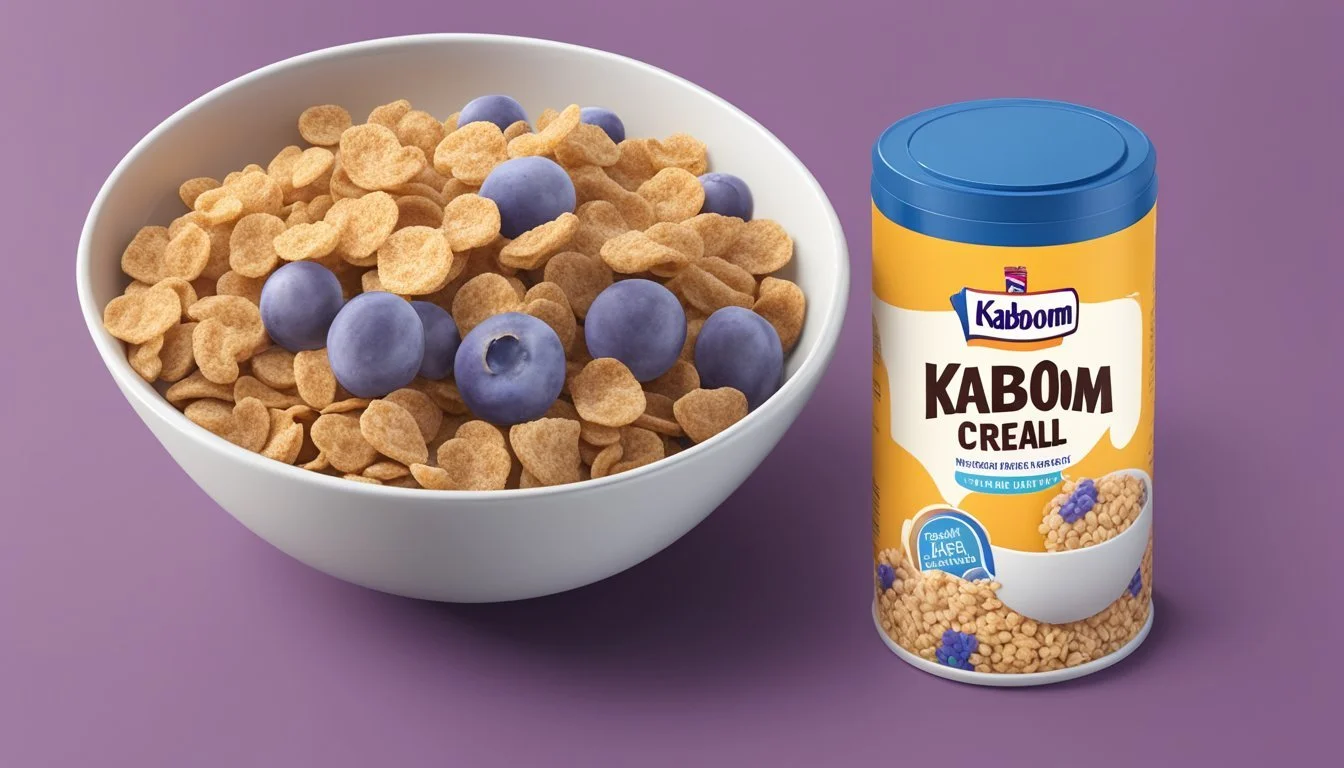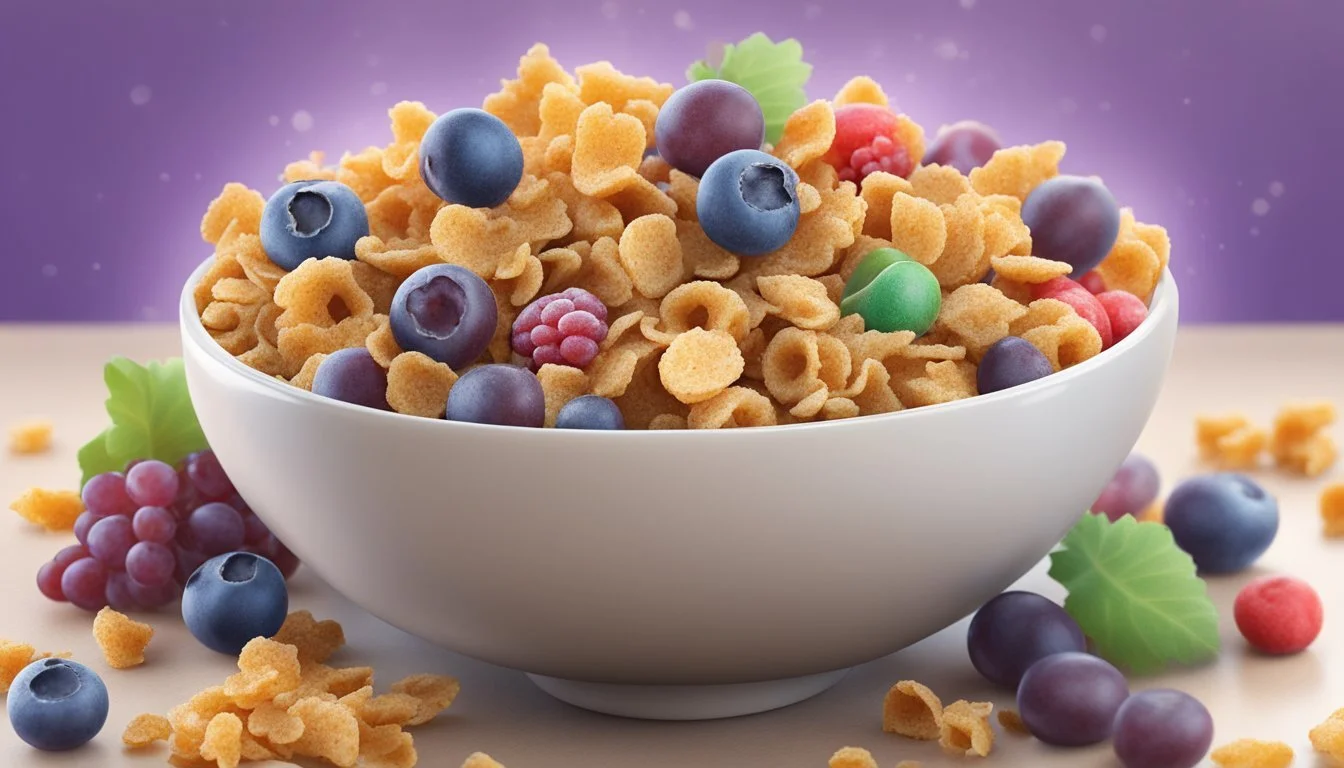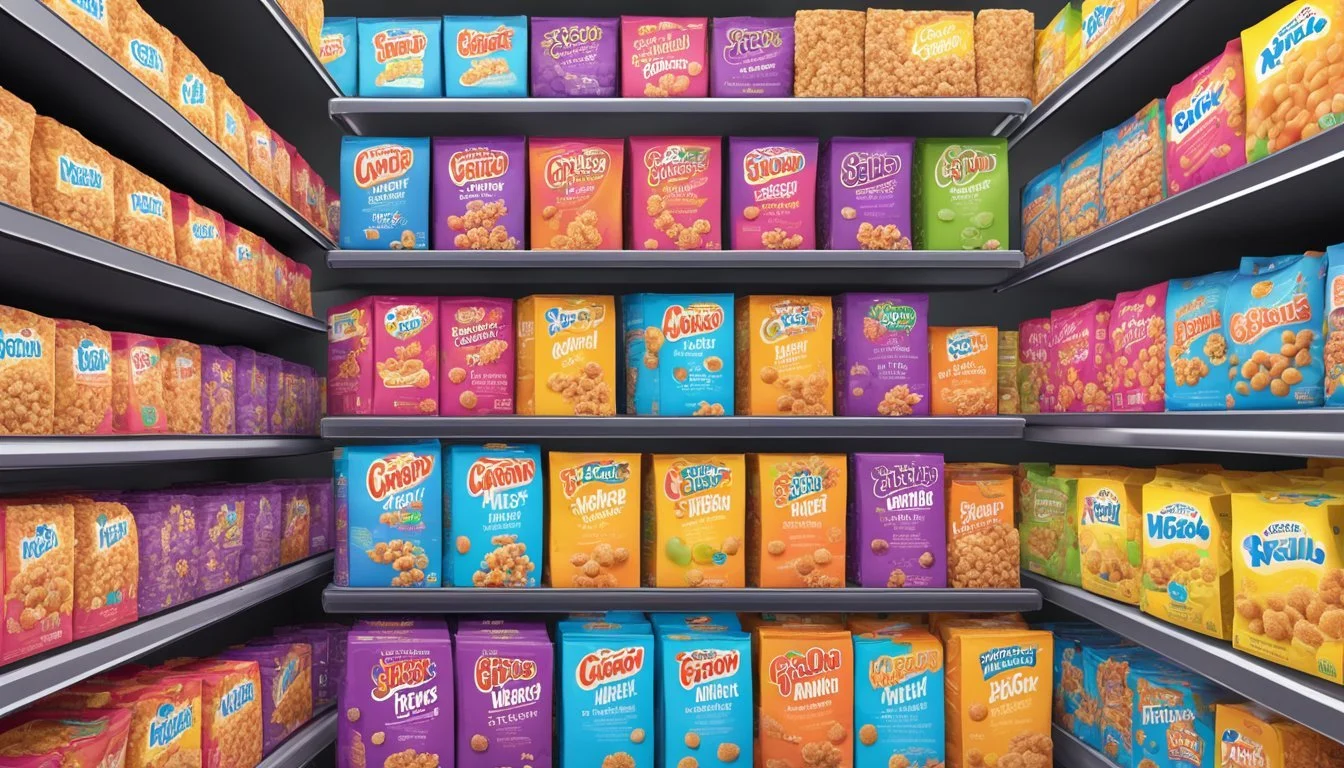Kaboom vs Post GrapevsNut Flakes
The Ultimate Breakfast Cereal Showdown
This Article is Part of Our Breakfast Cereal Guide with Details on Kaboom Nutrition and Post GrapevsNut Flakes Nutrition
When it comes to breakfast cereals, the debate between Kaboom and Post Grape-Nuts Flakes is a common one among health-conscious consumers. Kaboom, known for its colorful marshmallows and sugary taste, offers a nostalgic trip back to the sweet breakfasts of childhood. However, Post Grape-Nuts Flakes appeal to those prioritizing nutrition with their whole grain ingredients and heart-healthy benefits.
Although Kaboom may lure you in with its playful appearance and instant sugar rush, it's essential to consider the long-term effects of such a sweet start to your day. Post Grape-Nuts Flakes, on the other hand, provide 23 grams of whole grains per serving and are high in iron and folic acid. They also offer complex carbohydrates that fuel your body through the morning.
Health enthusiasts often lean towards Post Grape-Nuts Flakes, appreciating the blend of taste and nutrition they deliver. Packed with fiber and essential nutrients, Grape-Nuts Flakes can be a cornerstone of a balanced diet, helping to reduce the risk of heart disease when incorporated into a low-fat diet. For those weighing their options for a healthy breakfast, the choice is clearer when considering these factors.
Historical Background
Kaboom and Post Grape-Nuts Flakes both have unique historical roots that trace back to different eras and motivations in cereal manufacturing. These cereals have evolved, reflecting changes in breakfast habits and food science.
Development of Kaboom
Kaboom was introduced by General Mills in 1969. Marketed primarily towards children, the cereal featured colorful, circus-themed shapes and a clown mascot. Kaboom was fortified with vitamins to appeal to parents concerned about nutrition.
General Mills aimed to create a product that combined fun with health benefits. Through television commercials and eye-catching packaging, Kaboom quickly gained popularity in the breakfast cereal market.
Origin of Post Grape-Nuts Flakes
Post Grape-Nuts Flakes emerged from the original Grape-Nuts, developed by C. W. Post in 1897. C. W. Post, inspired by his time at John Harvey Kellogg’s sanitarium, sought to create a nutritious whole-grain cereal.
The Grape-Nuts brand grew rapidly, contributing to Battle Creek, Michigan, becoming the cereal capital of the United States. Post Grape-Nuts Flakes introduced a variant that maintained the health focus but offered a flakier texture and milder crunch.
An important aspect of Post Grape-Nuts Flakes’ history is its advertising that emphasized the cereal’s health benefits, potentially reducing heart disease. The tagline "the perfect food" and claims of being "better than gold" highlighted its nutritional value.
Nutritional Comparison
This section breaks down the nutritional content of Kaboom and Post Grape-Nuts Flakes cereals, focusing on various key components such as calories, fiber, protein, sugars, sodium, and essential vitamins and minerals.
Analyzing Caloric Content
When examining the caloric content, Kaboom cereal offers roughly 120 calories per serving, making it a relatively moderate option for those watching their calorie intake.
In contrast, Post Grape-Nuts Flakes provide about 110 calories per serving. This slight difference might not significantly impact daily intake, but it is worth noting for those counting every calorie.
Both cereals contribute to daily energy needs, with Kaboom being slightly higher in calories.
Fiber and Protein Contents
Fiber and protein are crucial for maintaining digestive health and building muscle, respectively. Kaboom cereal contains 3 grams of fiber and 2 grams of protein per serving.
Post Grape-Nuts Flakes, on the other hand, have 4 grams of fiber and 3 grams of protein per serving.
While both cereals offer beneficial amounts, Post Grape-Nuts Flakes provides a marginally better source of dietary fiber and protein.
Sugar and Sodium Levels
Sugar and sodium content are critical factors for those monitoring blood sugar levels and heart health. Kaboom cereal contains 10 grams of sugar and 190 mg of sodium per serving.
Comparatively, Post Grape-Nuts Flakes contain less sugar at 5 grams per serving and slightly higher sodium at 200 mg.
For those reducing sugar intake, Post Grape-Nuts Flakes might be a better option, though sodium levels remain similar.
Vitamins and Minerals
Kaboom cereal is fortified with several vitamins and minerals including Vitamin D (20% DV), Vitamin B6 (25% DV), Vitamin B12 (30% DV), Iron (20% DV), and Folic Acid (25% DV).
Post Grape-Nuts Flakes are also fortified, offering Vitamin D (10% DV), Vitamin B6 (30% DV), Vitamin B12 (25% DV), Iron (20% DV), Potassium (8% DV), and Zinc (15% DV).
While Kaboom tends to have higher percentages in certain vitamins, Post Grape-Nuts Flakes include a broader range, making it a nutritionally diverse option.
Ingredient Breakdown
Understanding the ingredients in Kaboom and Post Grape-Nuts Flakes is essential for making an informed choice. This section will explore key components such as signature ingredients, added sugars, whole grains, dietary fiber, and added vitamins and minerals.
Signature Ingredients
Kaboom and Post Grape-Nuts Flakes differ significantly in their signature ingredients. Kaboom uses a combination of whole grain wheat and wheat flour, offering a hearty base.
Post Grape-Nuts Flakes, on the other hand, incorporate malted barley flour alongside wheat flour. This malted barley flour gives the flakes their distinctive flavor and crunch.
Both cereals contain various other components typical of breakfast cereals, but their primary grains set them apart.
Added Sugars and Flavors
Kaboom has a more prominent sweet profile, often using added sugars and artificial flavors to appeal to children.
Grape-Nuts Flakes contain far less added sugar. They focus on natural flavors derived from their grains. The simplicity of the Grape-Nuts Flakes ingredients list means fewer additives and unnecessary sugars.
Added sugars can negatively impact health, so consumers mindful of their sugar intake might prefer Grape-Nuts Flakes.
Whole Grains and Dietary Fiber
Whole grains are a primary component in both cereals, but their sources vary. Kaboom uses whole grain wheat, while Grape-Nuts Flakes incorporate a mix of wheat flour and malted barley flour.
Dietary fiber is crucial for digestion. Kaboom provides a balanced mix of soluble and insoluble fibers, aiding overall gut health.
Grape-Nuts Flakes, renowned for their fiber content, excel in providing this nutritional benefit. Their high insoluble fiber content helps promote regular bowel movements and overall digestive health.
Added Vitamins and Minerals
Kaboom and Post Grape-Nuts Flakes are often fortified with a variety of essential vitamins and minerals.
Kaboom's formula can feature a range of vitamins, including Vitamin A Palmitate, niacinamide, and pyridoxine hydrochloride.
Post Grape-Nuts Flakes similarly incorporate these added vitamins and minerals, but often in more measured amounts. This fortification ensures that consumers gain nutrients that might be lacking in their daily diets.
The inclusion of such essential vitamins and minerals helps enhance the nutritional profiles of both cereals, making them a valuable part of a balanced breakfast.
Health Considerations
Both Kaboom cereal and Post Grape-Nuts Flakes come with unique health profiles that may influence blood sugar control, cardiovascular health, and weight management.
Effects on Blood Sugar Control
Kaboom cereal has a relatively high sugar content. 18 grams of sugar per serving can cause spikes in blood glucose levels, which is a concern for those managing Type 2 Diabetes. High sugar intake leads to increased insulin demand, potentially contributing to insulin resistance over time.
Conversely, Post Grape-Nuts Flakes contain less sugar, which may make them a better option for blood sugar control. They provide 15 grams of complex carbohydrates per serving, which break down more slowly and help stabilize blood sugar levels. This makes them suitable for those on a Keto Diet or looking to maintain consistent energy levels throughout the day.
Cardiovascular Health
Heart health is crucial, and both cereals offer different advantages and drawbacks. Kaboom's higher sugar content and total fat make it less favorable for heart health. High sugar diets are associated with increased cholesterol levels and a higher risk of heart disease.
Post Grape-Nuts Flakes are rich in dietary fiber, with benefits for cholesterol reduction. Fiber can help lower LDL (bad) cholesterol and maintain healthy blood pressure levels. The cereals are relatively low in total fat, and Post Grape-Nuts Flakes have minimal saturated and trans fats, supporting heart health further.
Weight Management and Diet
When considering calories per serving, Kaboom provides 240 calories per 1 1/4 cup serving. This could add up quickly if portion sizes aren’t controlled. Its high sugar content could lead to quicker energy crashes and hunger pangs, complicating weight management efforts.
Post Grape-Nuts Flakes offer a more nutritious composition with 150 calories per serving. The higher fiber content in Grape-Nuts Flakes aids in satiety, helping to manage hunger and support weight loss or maintenance. Nutrition experts often recommend high-fiber cereals for those on weight management diets due to their ability to promote fullness and reduce overall calorie intake.
Taste and Texture Profiles
Both Kaboom and Post Grape-Nuts Flakes offer unique taste experiences and textures that set them apart in the cereal aisle. They cater to different palates and preferences in terms of flavor, sweetness, and mouthfeel.
Grapenuts' Iconic Taste
Grape-Nuts Flakes feature a distinct toasted grain flavor. This toasted profile is accompanied by subtle hints of maltiness, derived from whole grain wheat.
The sweetness level in Grape-Nuts Flakes is mild, fitting well for those who prefer less sugary cereals. Mixed with milk, the flakes soften slightly but maintain a satisfying crunch.
The cereal delivers a wholesome, grainy texture that appeals to fans of traditional, hearty breakfast options.
Kaboom's Flavor Experience
Kaboom is known for its vibrant and playful flavor profile. The cereal features brightly-colored, star-shaped pieces that combine a mix of fruity and sugary tastes.
Each bite offers a burst of artificial fruit flavors, providing a more youthful and fun experience in comparison to Grape-Nuts Flakes. The cereal is quite sweet, appealing to those who enjoy a more indulgent breakfast option.
When milk is added, Kaboom retains a satisfying crunch but tends to soften quickly, allowing the flavors to meld together in the bowl.
Comparing Cereal Textures
Post Grape-Nuts Flakes are known for their crisp, grainy texture. The thin flakes remain crunchy in milk for an extended period, making them a popular choice for those who enjoy texture variety in a single bowl.
Kaboom, on the other hand, features a lighter, puffier texture. The star-shaped pieces create a different mouthfeel, softer and more playful when compared to the dense, hearty nature of Grape-Nuts Flakes.
While Grape-Nuts Flakes focus on delivering a robust, toasted grain experience, Kaboom offers a more airy, fruit-flavored crunch. These differences highlight unique approaches to texture and taste, catering to individual preferences.
Consumer Experience
In examining the consumer experience of Kaboom and Post Grape-Nuts Flakes, details such as breakfast routine integration, packaging, and branding are key factors. These considerations highlight how these cereals fit into daily life and appeal to their target audiences.
Breakfast Routine Integration
Kaboom and Post Grape-Nuts Flakes offer unique experiences in the morning ritual. Kaboom, with its colorful marshmallows, aims to bring fun and excitement to kids' breakfast bowls. Its sugary content might appeal more to children and those seeking a nostalgic, sweet start to their day.
Post Grape-Nuts Flakes, on the other hand, provide a crunchy, whole-grain option for those focusing on health and nutrition. They offer 15 grams of complex carbohydrates per serving, making them heart-healthy and suitable for sustained energy. Adding milk helps soften their texture, making them a hearty option for adults.
Both cereals accommodate different dietary preferences. Kaboom typically does not fit vegan or keto diets due to its sugar and dairy-based marshmallows, while Grape-Nuts Flakes’ whole-grain ingredients align better with health-conscious consumers.
Packaging and Branding
Kaboom: Kaboom cereal capitalizes on vibrant, playful packaging with cartoon characters, which resonates well with children and nostalgic adults. The bright colors and fun font styles are designed to catch the eye and stand out on the shelves, contributing to its kid-friendly image.
Post Grape-Nuts Flakes: Post Grape-Nuts Flakes sport a more subdued, professional look with emphasis on health claims. The packaging highlights “Heart Healthy” and “Whole Grain” prominently, appealing to those looking for nutritious options. It also often includes detailed nutritional information to reinforce its healthy image.
Both brands use their packaging to effectively communicate their unique selling propositions, whether it’s the joyous, sweet escape of Kaboom or the robust, health-focused reality of Grape-Nuts Flakes.
Culinary Applications
Kaboom and Post Grape-Nuts Flakes offer versatile options for culinary creativity. Whether using them as a topping, ingredient, or base, both cereals open up new possibilities in the kitchen.
Cereal Beyond the Breakfast Bowl
Kaboom and Post Grape-Nuts Flakes can easily transcend traditional breakfast roles. They work well as crunchy toppings for yogurt, giving an additional texture and nutritional boost. Add raisins to enhance sweetness.
Trail mixes with cereal, nuts, and dried fruits are perfect for snacking. These cereals provide a satisfying crunch and nutritional value. You can even use them as a breading alternative for chicken or fish, offering a unique twist on classic recipes.
Creative Recipes Using Cereal
Grape-Nuts Flakes and Kaboom are excellent ingredients in various baking projects. Incorporate them into muffin or cookie recipes for added crunch. Mixing these cereals into pancake batter can result in delightful, textured pancakes.
For those who enjoy experimenting, try breaking down the cereals to use as a pie crust base. Simply crush them and mix with melted butter to create a sturdy crust, ideal for cheesecakes or tart fillings.
Adding them to granola bars with raisins and honey makes for a nutritious, portable snack. These recipes showcase the versatility and enhancements both cereals can bring to everyday culinary endeavors.
More on Kaboom
More on Post GrapevsNut Flakes
Cinnamon Toast Crunch vs Post GrapevsNut Flakes: Which is better?
French Toast Crunch vs Post GrapevsNut Flakes: Which is better?
Honey Nut Cheerios vs Post GrapevsNut Flakes: Which is better?
Kellogg's Apple Jacks vs Post GrapevsNut Flakes: Which is better?
Kellogg's Froot Loops vs Post GrapevsNut Flakes: Which is better?
Post GrapevsNut Flakes vs Post Raisin Bran Cereal: Which is better?









